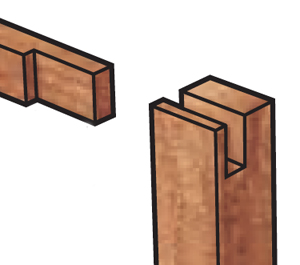
Tim Inman: Your joint is a through tenon. Bridle joints are typically used to join at corners, for example on stiles and rails of doors. I’ve never heard of a halter joint — but maybe somebody remembered it had something to do with horses and horse tack (bridles) and got as far as the halter … On Mission style furniture, I have frequently seen through tenons which are decorated by allowing the tenon to extend a little beyond the mortised piece (usually an arm or a tabletop) and then the tenon is cut to roughly resemble a pyramid. I have also, even more frequently, found those little pyramids to be just a loose piece of wood glued on to “imply” a through tenon.
Chris Marshall: Oh, what’s in a name?! As a woodworking writer, Ron, I know your dilemma here. We do toss around a lot of jargon, don’t we? Just to check yet another (!) source, I pulled from my woodworking collection a book called Classic Joints with Power Tools, written by Yeung Chan. He labels the corner joint you are describing as a “slip joint” and an “open tenon joint.” So there: two more options to add to the medley for this simple, sturdy mortise-and-tenon style. Mr. Chan considers a “bridle” joint to be one that lands midway along a workpiece, not at a corner. I think of a “through tenon” as one that is captured all around by the mating workpiece, except for the end of the tenon that protrudes. So, I would not call the joint you are describing a through tenon, because you can see both an edge of the tenon as well as the end.





